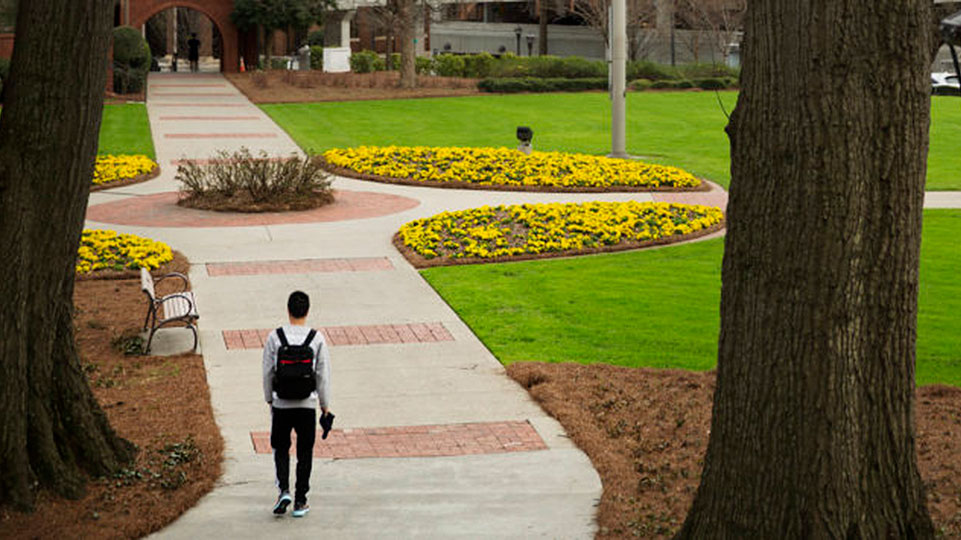
NEWMARKET, N.H. — Students across the nation are preparing for the most turbulent semester of their lives.
Post-secondary school administrators have started rolling out their strategies to combat the surge of COVID-19 cases and prevent a public relations disaster as the result of subsequent cluster outbreaks on their campuses.
While it’s safe to say that no one is anticipating the quintessential college experience this fall, many students have expressed their concerns and dissatisfaction regarding their institution’s preparation, as well as their steadfast approach to charging students the full cost of tuition.
“They aren’t doing anything extra except for saying you have to sit six feet apart in class and everywhere we go we have to have three masks with us,” said Sarah Corrow, a second-semester senior at the University of New Hampshire (UNH).
As the United States begins the long and arduous climb out of the economic hole dug by the pandemic, Trump has been threatening to cut back funding to schools that refuse to reopen. While CNN has reported that “Trump can’t unilaterally cut current federal funding for schools,” he could “refuse to sign future legislation for federal grants and bailouts for schools.”
Trump loyalist and New Hampshire Governor Chris Sununu took this to heart and announced his reopening guidelines for primary schools, which excludes a mask decree at a state level. Each school district will have the flexibility to adapt their own guidelines without consulting public health officials.
However, Sununu broadcast on July 16 that the University System of New Hampshire will be receiving an additional $19 million in federal funding without attaching any safety regulations or recommendations.
A primary concern for immunocompromised individuals is the neglect of safety precautions by groups of students who disregard the severity of the pandemic and continue to gather.
“I’m high-risk and I don’t trust teenagers and young 20-somethings to be safe and uphold CDC recommendations,” said Natalie Czepiel, a senior majoring in Neuroscience and Behavior.
“I know that I’m going to be safe, but I don’t know what others will do. I don’t want to target Greek Life, but a huge part of their social experience is parties. Who’s going to enforce social distancing at a fraternity party?”
UNH’s COVID-19 page delivers a statement on their approach to welcoming students back on campus: “UNH is developing a flexible, in-person fall 2020 experience designed to keep our community safe, ensure access and quality for our students, and move our community forward.”
In May 2020, UNH President James W. Dean Jr. released an announcement to students in regard to meeting safety recommendations: “Students can choose to stay home, be on campus and go to class, or be on campus but only attend some classes in person.”
On July 21, Provost Wayne Jones retracted that safety net in a university-wide email: “While the deans’ offices and faculty are still working hard to finalize exact details, I can assure you that a majority of classes, more than 60%, are expected to be face-to-face, even with COVID-19 capacity limits.”
Furthermore, Professor and Chairwomen of the Department of Biological Sciences Bonnie L. Brown informed students of their coronavirus testing practices: “We recently learned that all students and faculty will get regular testing (each person roughly every 4 days) through a molecular lab at UNH and that results are expected within 24 hours.”
On-campus testing is expected to occupy a vast majority of university resources, from laboratory facilities and personnel to CARES Act federal funding.
One facet of safeguarding students and faculty from the novel coronavirus is to perform rigorous campus-wide testing. Administrators proposed testing students once every four days; an astronomical feat that would result in 940 tests per day.
The question must be asked: Why enforce online classes last spring when cases were less than 100 in New Hampshire, and return at over 6,000 at the time of writing?
For starters, colleges and universities operate under the same umbrella as every capitalist business: generate revenue or implode. For post-secondary institutions, that means drawing in students as customers.
In the spring of 2020, the main UNH campus in Durham had just shy of 15,000 undergraduate and graduate students. While official numbers have not been released by administrators, institutions across the country are projected to see enrollment decline between 5% and 20%, according to Fitch Ratings.
That is enough loss in revenue to have administrators strategizing on how to lure customers—students—back to their campuses without negotiating tuition reimbursements.
Not all classes are so easy to migrate to an online platform as a creative writing or programming course. Science laboratories, culinary arts kitchens, and trade programs generally require hands-on demonstrations. When the outbreak of COVID-19 became a national crisis in late March, professors had to quickly transition to online learning.
But four months after the pandemic took the stage, department chairpersons have yet to develop an alternative for these degree paths.
“A lot of my classes could be online, but they aren’t even offered,” said Natalie Czepiel. “They aren’t making it easy to seek out the online classes.”
Students at UNH believe that these funds won’t be allocated properly for ensuring student safety but instead be parceled off for capitalist cupidity.
“I think they’re taking our money and putting it back where they lost it in the spring,” said Sarah Corrow.
“They’re putting their money into lost revenue from sports, like ticket sales, etc. I don’t think it’s being used the way we think. They aren’t hiring any new janitorial staff because no one is willing to work there.”
“If we went completely online, UNH would lose a ton of money and implode,” said Czepiel. “They’re claiming that they are going to be testing everyone on campus, so over 12,000 people, every four days. That’s very expensive. Also, working through the Department of Biological Sciences, I know that they spent many thousands of dollars just putting up plexiglass in between lab stations. This is all a huge waste if we inevitably go fully online again in October, which many people think we will.”
UNH administrators declined to comment on faculty layoffs. However, at UNH mailing services and the Browne Center for Innovative Learning, the entirety of their staff, with the exception of three employees, have been furloughed.
With omnipresent furloughs and layoffs occurring almost daily, students are still not confident that their tuition is being spent on safety precautions.
“I think their main concern is capital gain, easily,” said Corrow. “They made their decision to go back to in-person lectures very early. And interestingly, they made that choice days before the date when freshman had to decide whether they were going to attend or defer. But even if we end up going online, those freshmen who were enticed by the idea of going to campus are still going to pay $40,000 to be at home.”
The objective for incoming and returning students this fall is to continue their education with at least a slight semblance of normalcy, even if that means online lectures and Zoom meetings to replace face-to-face interactions. Without the ability to socialize in the dining hall or attend extracurricular club meetings, their zeal to take on vast amounts of student loans for an online stopgap is swiftly deteriorating. “If I do have to take all my classes online, I will be very upset,” said Czepiel. “Trying to reason with the UNH administration is like screaming into the void. It’s a corporate entity that preys on the working class; you can bargain for online classes, but they’ll never give you reduced tuition. They just want their payday, no matter the lives it costs.”












Comments